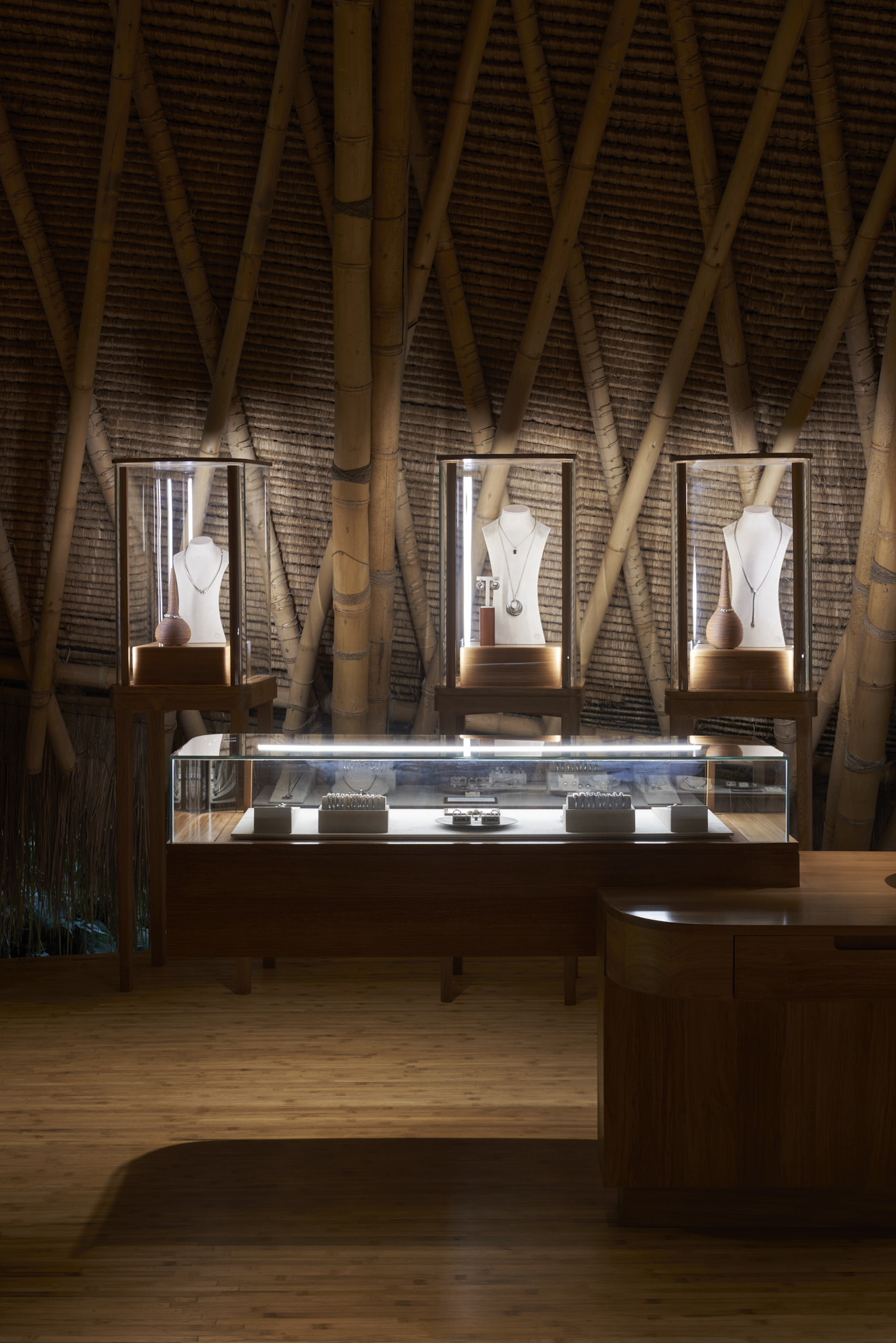
John Hardy Boutique | Interior Design
Completed
At the storied John Hardy Kapal Jewelry workshop in Ubud, the new interior design for the space sought for a fluid interior that spoke of the buildings history and context. Elevated above swooping rice terraces, the new interior drew inspiration from nature and its beautiful irregularities. Working hand in hand with John Hardy’s design team in New York and Bali this update was a long time in the making. It felt right to elevate the spaces, but the challenge was always staying respectful to the brand’s sustainability values and the fact that this was the first bamboo building in Bali that took what was considered to be a poor mans temporary building material, bamboo, and created Bali’s first architectural bamboo icon, designed by Yew Kuan Cheong.
Forms of the showcases and vitrines mirror Ubud’s landscapes while looking to create an intrigue in visitors for what treasures are found within. A warm intimate emotion is evoked, as if being inside of an illuminated bamboo forest surrounded by all natural materials but every design detail is intentional: cantilevered showcases, custom designed hanging lamps from twisted solid wood and glass displays curved by hand.
Collaborating with local woodworking company, Kalpa Taru Bali to craft its delicate designs, there was a need to push the boundaries of modern carpentry while staying true to its heritage roots and sustainability. The challenge was always finding a balance, whether that was finding a way to make a display float three meters or a respect for existing space with so much history while wanting to bring a modern edge or choosing a long lasting sustainable teak and bamboo.
Forms of the showcases and vitrines mirror Ubud’s landscapes while looking to create an intrigue in visitors for what treasures are found within. A warm intimate emotion is evoked, as if being inside of an illuminated bamboo forest surrounded by all natural materials but every design detail is intentional: cantilevered showcases, custom designed hanging lamps from twisted solid wood and glass displays curved by hand.
Collaborating with local woodworking company, Kalpa Taru Bali to craft its delicate designs, there was a need to push the boundaries of modern carpentry while staying true to its heritage roots and sustainability. The challenge was always finding a balance, whether that was finding a way to make a display float three meters or a respect for existing space with so much history while wanting to bring a modern edge or choosing a long lasting sustainable teak and bamboo.
John Hardy | Mambal
At the storied John Hardy Kapal Jewelry workshop in Ubud, the new interior design for the space sought for a fluid interior that spoke of the buildings history and context. Elevated above swooping rice terraces, the new interior drew inspiration from nature and its beautiful irregularities. Working hand in hand with John Hardy’s design team in New York and Bali this update was a long time in the making. It felt right to elevate the spaces, but the challenge was always staying respectful to the brand’s sustainability values and the fact that this was the first bamboo building in Bali that took what was considered to be a poor mans temporary building material, bamboo, and created Bali’s first architectural bamboo icon, designed by Yew Kuan Cheong.
Forms of the showcases and vitrines mirror Ubud’s landscapes while looking to create an intrigue in visitors for what treasures are found within. A warm intimate emotion is evoked, as if being inside of an illuminated bamboo forest surrounded by all natural materials but every design detail is intentional: cantilevered showcases, custom designed hanging lamps from twisted solid wood and glass displays curved by hand.
Collaborating with local woodworking company, Kalpa Taru Bali to craft its delicate designs, there was a need to push the boundaries of modern carpentry while staying true to its heritage roots and sustainability. The challenge was always finding a balance, whether that was finding a way to make a display float three meters or a respect for existing space with so much history while wanting to bring a modern edge or choosing a long lasting sustainable teak and bamboo.
Forms of the showcases and vitrines mirror Ubud’s landscapes while looking to create an intrigue in visitors for what treasures are found within. A warm intimate emotion is evoked, as if being inside of an illuminated bamboo forest surrounded by all natural materials but every design detail is intentional: cantilevered showcases, custom designed hanging lamps from twisted solid wood and glass displays curved by hand.
Collaborating with local woodworking company, Kalpa Taru Bali to craft its delicate designs, there was a need to push the boundaries of modern carpentry while staying true to its heritage roots and sustainability. The challenge was always finding a balance, whether that was finding a way to make a display float three meters or a respect for existing space with so much history while wanting to bring a modern edge or choosing a long lasting sustainable teak and bamboo.


